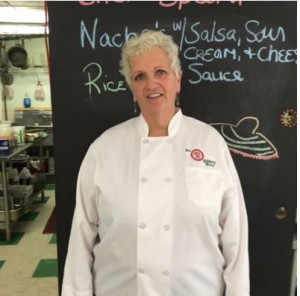http://www.miltonindependent.com/boosting-school-lunch/
Georgia students can expect more variety for lunch when they return to school next week.
In preparation for hordes of hungry kids filing into the GEMS cafeteria, workers are installing new refrigerated display cases and a panini grill to expand lunch offerings.
The upgrades are funded by $40,000 of the 2015 surplus, one of the school board’s attempts to spend down the money before the end of the fiscal year.
The board received a wish list of sorts for cafeteria equipment needs from Scott Choiniere, Abbey Group vice president of operations and GEMS food service representative, and new chef Peter Siegfried in the spring.
The board also OK’d the purchase of two new milk coolers, a convection oven, an ice cuber, plus two cash register stations and $3,000 of small wares. Only a request for more walk-in cooler storage was tabled due to lack of space, Choiniere said.
“The school board is invested in the program,” he said. “There’s definitely going to be a lot more variety [for students].”
This year, for $2.25, students can now choose from made-to-order sandwiches, panini specials, express items like chicken or pulled pork sandwiches, a chef’s special and fresh grab- and-go items like cheese, fruit, hummus, chips and salsa and three varieties of pizza cooked on the new conveyor.
“The freshness of it is going to help,” Choiniere said. “We’re going to do cooking in front of the kids, so you’re going to have that smell in the room, too.”
Pizzas were previously cooked in the kitchen, connected to the cafeteria by a corridor. As a result, in recent years, the school fielded complaints about food quality, temperature and freshness.

The board attempted to address this with a $3 million bond for a cafeteria expansion and redesign. Plans proposed abutting the kitchen and cafeteria and growing the 2,651 square foot space that officials say is incredibly cramped come lunchtime.
But Georgia voters nixed the bond on Town Meeting Day, approving the $12.8 million school budget and a separate $2.4 million bond to replace the building’s outdated HVAC system.
Board member Ben Chiappinelli has indicated the cafeteria project will return, but for now, the small-scale improvements will help, Choiniere said, despite having no extra space.
Choiniere estimated about 100 students come through the lunchroom each shift: “We’re doing the best that we can do with what we have,” he said.
Chef Siegfried came to Georgia at the tail end of the last school year after running kitchens at IBM and the University of Vermont, and Choiniere is especially excited about what the New England Culinary Institute-educated chef can bring to the table.
Siegfried and Choiniere are both dedicated to starting a farm-to-school program at GEMS, provided they drum up enough volunteer support. Choiniere envisions a vegetable garden, fruit trees or even a greenhouse for growing a hyperlocal lunch or for an outdoor classroom.
“The sky’s the limit,” he said, citing other school Abbey programs that make maple syrup or even raise livestock. “It’s still in the planning stages … we need to get some people with a passion for it to help us.”
Teachers are showing interest, and the school board is in favor, but funding is still a question. One Maine school leveraged a parent’s skills as a landscape architect; its walking paths, school garden and orchard were all designed for free, Choiniere noted.
The Abbey Group locally sources as much of its food as possible, but you can’t get much closer than your own backyard. Choiniere envisions school-wide planting days and outdoor math and science lessons someday.
He’s well aware of neighboring Milton Town School District’s success with its own program, nationally recognized for its excellence in 2013 when First Lady Michelle Obama invited fifth-graders to plant and harvest vegetables in the White House garden.
“We want to go to the White House; we want to be in the magazines,” Choiniere said. “Everybody’s got to get together … it can go a lot of places.”
To help establish Georgia’s burgeoning farm-to-school program, contact Chef Peter Siegfried at 524-6358.
Read more ›

